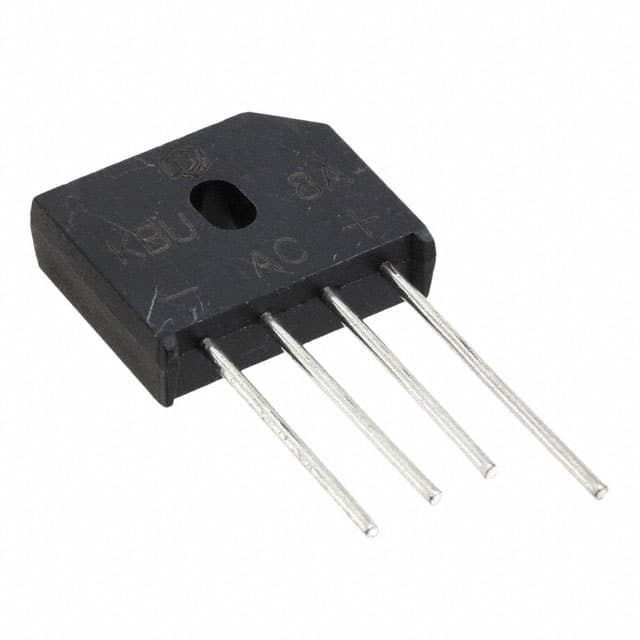KBU6D Diode Bridge Rectifier
Product Overview
The KBU6D diode bridge rectifier belongs to the category of electronic components and is commonly used in power supply circuits to convert alternating current (AC) to direct current (DC). Its characteristics include high efficiency, compact size, and reliable performance. The package typically consists of a molded plastic body with metal leads for connection. The essence of the KBU6D lies in its ability to efficiently rectify AC voltage into DC, making it suitable for various electronic applications. It is commonly available in standard packaging with varying quantities per package.
Specifications
- Maximum Average Forward Current: 6A
- Maximum Peak Reverse Voltage: 600V
- Operating Temperature Range: -55°C to +150°C
- Mounting Type: Through Hole
- Package / Case: KBU
Detailed Pin Configuration
The KBU6D diode bridge rectifier typically consists of four pins arranged in a square configuration. The pinout is as follows: 1. Pin 1: AC Input + 2. Pin 2: AC Input - 3. Pin 3: DC Output + 4. Pin 4: DC Output -
Functional Features
- Full-wave Rectification: Converts both halves of the input AC waveform into DC.
- Low Forward Voltage Drop: Ensures minimal power loss during rectification.
- High Isolation Voltage: Provides enhanced safety and reliability in high-voltage applications.
Advantages and Disadvantages
Advantages
- Compact Size: Suitable for space-constrained applications.
- High Efficiency: Minimizes power loss during conversion.
- Reliable Performance: Ensures stable operation over extended periods.
Disadvantages
- Heat Dissipation: May require additional heat sinking in high-power applications.
- Voltage Drop: Exhibits a small forward voltage drop, impacting overall efficiency in some scenarios.
Working Principles
The KBU6D operates on the principle of diode bridge rectification, where the arrangement of diodes allows for the conversion of AC input into DC output. During the positive half-cycle of the input AC waveform, diodes D1 and D2 conduct, allowing current to flow through the load in one direction. Conversely, during the negative half-cycle, diodes D3 and D4 conduct, ensuring continuous DC output.
Detailed Application Field Plans
The KBU6D diode bridge rectifier finds extensive use in various applications, including: - Power Supplies: Used in AC to DC converters for electronic devices and equipment. - Motor Drives: Employed in motor control circuits to provide DC power. - Lighting Systems: Utilized in LED drivers and lighting control circuits.
Detailed and Complete Alternative Models
- KBU6J: Similar specifications with a different package type.
- KBU6M: Higher voltage rating with comparable current capacity.
- KBU8D: Higher current capacity with similar voltage rating.
In conclusion, the KBU6D diode bridge rectifier offers a compact and efficient solution for converting AC to DC in a wide range of electronic applications, making it a versatile component in modern electronics.
Word Count: 443
Lista 10 Vanliga frågor och svar relaterade till tillämpningen av KBU6D i tekniska lösningar
What is KBU6D?
- KBU6D is a bridge rectifier component commonly used in electronic circuits to convert alternating current (AC) to direct current (DC).
What are the typical applications of KBU6D?
- KBU6D is commonly used in power supplies, battery chargers, and other electronic devices that require conversion of AC to DC.
What is the maximum average forward rectified current for KBU6D?
- The maximum average forward rectified current for KBU6D is typically 6A.
What is the maximum repetitive peak reverse voltage for KBU6D?
- The maximum repetitive peak reverse voltage for KBU6D is typically 600V.
Can KBU6D be used in high-temperature environments?
- Yes, KBU6D is designed to operate in relatively high-temperature environments, but it's important to consider heat dissipation and derating guidelines.
What is the typical junction temperature range for KBU6D?
- The typical junction temperature range for KBU6D is -55°C to +150°C.
Does KBU6D require external heat sinks for certain applications?
- In high-power applications or when operating at elevated temperatures, using external heat sinks may be necessary to ensure proper thermal management.
Are there any recommended mounting techniques for KBU6D?
- It is recommended to use through-hole mounting with appropriate insulation and thermal considerations for efficient and reliable performance.
What are the key electrical characteristics of KBU6D?
- Key electrical characteristics include low forward voltage drop, high surge current capability, and low leakage current.
Is KBU6D suitable for automotive applications?
- KBU6D can be used in certain automotive applications, but it's important to verify its compatibility with specific automotive standards and requirements.


